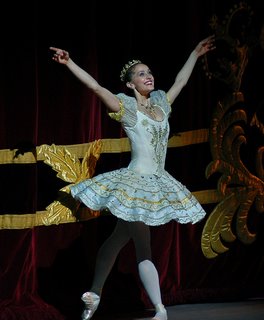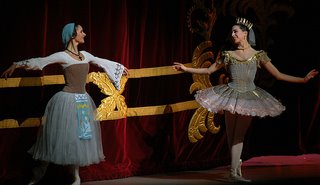ROYAL BALLET COPPELIA [20TH OCT'06]
MARIANELA NUNEZ THIAGO SOARES WILLIAM TUCKETT

Curtain Call, Marianela Nunez and Thiago Soares
Coppelia was created in the period when Romanticism in ballet crossed over to Imperialism. Tutus became shorter, showing more legs, and more technique.
Hence the arm lines maintained the Romantic feel, while the leg lines followed the Classical trademark. Centuries after the introduction of Romantic ballet, this tradition is still strongly maintained by many professional companies around the world, despite the huge evolution of the classical technique.
The second performance by the Nunez’s and Soares’ Coppelia partnership at the Royal Opera House, was a divine showcase of how the rustic tradition of Romantic meets Classical. Benjamin Pope once again led the orchestra to full heights with Delibes’ score. William Tuckett provided the X-factor to the ballet with his Dr Coppelius. His use of subtle actions and gestures, replacing explicit miming, results in enormous dramatic effects and intentions. In the final act, when he insisted more money from the Duke, instead of physically pointing his finger at that extra bag of money, he just did a tilt of his chin to acknowledge, “and that?” Act 1, when he realized his house has been broken into, he instantly brought up his walking stick as a form of self defence, which is atypical sight on stage. Tuckett’s Dr Coppelius was just right for me, not too much over the top.

Curtain call: Marianela Nunez as Swanhilda
Nunez demonstrated her thorough understanding of the repertoire requirement. She maintained a forward tilt in her upper body framed with soft and rounded arm lines, demonstrating the Romantic movement style. An alluring and expressive Swanhilda with sincere smiles that charmed the audience. Soares, tailored as Franz, portrayed the role almost as true to what the character should be. A clueless, simple-minded lad looking for a fling but still truly in love with Swanhilda. Soares’ made Franz’s fling with a ‘real’ girl, Leading peasant girl (danced by Sian Murphy), as a mission to provoke jealousy in Swanhilda. This may be Franz’s way of testing Swanhilda’s true love for him, just the same as she questioned his sincerity with an ear of corn. It is all good intention, I would say. Their peasant-ly love chemistry was maintained strongly throughout the ballet. During the Mazurka, Franz made several attempts to 'make up' to Swanhilda by relentlessly showing kisses and affection, trying to win her back. Unfortunately, she rejected and walks away from him. There was a point when Franz flouted at Swanhilda, she sneered back at him, as she haughtily did her relevé passés at the end of her Act 1 solo. Also, during the Czardas, Swanhilda was still fuming with anger and overwhelming with jealousy, her friends surround her to calm her down by fanning their skirts in her face. Victoria Hewitt as one of Swanhilda’s friends, was excellent and mimed very well with the music. Jubilant performance from the peasant girls, boys and Swanhilda’s friends. Special mention of Romany Pajdak and Steven McRae’s charismatic performance with splendid use of the upper body and wonderful execution in their Mazurka and Czardas.
Watching from a different view in the auditorium, one saw the majestic sets for Act 2. Thoroughly impressive stage design, the use of the high beams in Dr Coppelius’ workshop/house was cleverly made to create a realistic perspective, displaying depth and form. Nunez exaggerated bossy stride across the stage was comical, but appropriate for her character.
In the final Act, the Hours corps were beautiful to watch with soft fluid use of the arms, and neat footwork. A control and confidant Aurora from Alexandra Ansanelli. Gemma Sykes tackled her demanding and challenging solo with care and grace. The choreography in this Prayer solo may looked easy, but doing all the slow adagio and balancing with a small wooden platform of her pointe shoe, on a spacious stage with a spotlight shining on her throughout the solo and the pressure from the orchestra (because of the duration of her balance in sync with the music), and the audience, is definitely no easy peasy. My heart goes out to all Prayers.
Curtain call: Gemma Sykes as Prayer (left) and Alexandra Ansanelli as Aurora (right)
The grand pas de deux, by lead couple Nunez and Soares, was ever so beautiful to watch (over and over again). Nunez grasped Delibes’ music in her body, and made her body express what the music is trying to express. At the end of her Adagio with Soares, and the slow music towards the end, she lyrically unfolds her body as her leg unfolds into an arabesque. Their affectionate adagio was united with control, and it was a lovely sight.
Soares’s solo was wonderfully executed. He maintained the characterization of Franz’s charming demi-character style and performed his solo with flair, and gusto. He was probably born to dance Franz.
Nunez’s solo is impeccable with an extra touch of vivacity and charm. By this time, both dancers have probably just warmed the audience up in preparation for their exhilarating coda. A fearless coda from both dancers; Soares soaring into the air with his jumps while Nunez attacked with a leap into each of her posés pirouettes en dedan en manège.
It was a superb performance that was tremendously enjoyed. Details are strongly acknowledged and not being taken lightly by Christopher Carr, Grant Coyle, the notators, the coaches and, of course, the dancers. I greatly appreciate Royal Ballet for keeping this tradition of Dame Ninette de Valois, Lev Ivanov and Enrico Cecchetti alive. This is one way how ballet is passed on to our children and the generations that follow. Kudos to all.

Curtain Call, Marianela Nunez and Thiago Soares
Coppelia was created in the period when Romanticism in ballet crossed over to Imperialism. Tutus became shorter, showing more legs, and more technique.
Hence the arm lines maintained the Romantic feel, while the leg lines followed the Classical trademark. Centuries after the introduction of Romantic ballet, this tradition is still strongly maintained by many professional companies around the world, despite the huge evolution of the classical technique.
The second performance by the Nunez’s and Soares’ Coppelia partnership at the Royal Opera House, was a divine showcase of how the rustic tradition of Romantic meets Classical. Benjamin Pope once again led the orchestra to full heights with Delibes’ score. William Tuckett provided the X-factor to the ballet with his Dr Coppelius. His use of subtle actions and gestures, replacing explicit miming, results in enormous dramatic effects and intentions. In the final act, when he insisted more money from the Duke, instead of physically pointing his finger at that extra bag of money, he just did a tilt of his chin to acknowledge, “and that?” Act 1, when he realized his house has been broken into, he instantly brought up his walking stick as a form of self defence, which is atypical sight on stage. Tuckett’s Dr Coppelius was just right for me, not too much over the top.

Curtain call: Marianela Nunez as Swanhilda
Nunez demonstrated her thorough understanding of the repertoire requirement. She maintained a forward tilt in her upper body framed with soft and rounded arm lines, demonstrating the Romantic movement style. An alluring and expressive Swanhilda with sincere smiles that charmed the audience. Soares, tailored as Franz, portrayed the role almost as true to what the character should be. A clueless, simple-minded lad looking for a fling but still truly in love with Swanhilda. Soares’ made Franz’s fling with a ‘real’ girl, Leading peasant girl (danced by Sian Murphy), as a mission to provoke jealousy in Swanhilda. This may be Franz’s way of testing Swanhilda’s true love for him, just the same as she questioned his sincerity with an ear of corn. It is all good intention, I would say. Their peasant-ly love chemistry was maintained strongly throughout the ballet. During the Mazurka, Franz made several attempts to 'make up' to Swanhilda by relentlessly showing kisses and affection, trying to win her back. Unfortunately, she rejected and walks away from him. There was a point when Franz flouted at Swanhilda, she sneered back at him, as she haughtily did her relevé passés at the end of her Act 1 solo. Also, during the Czardas, Swanhilda was still fuming with anger and overwhelming with jealousy, her friends surround her to calm her down by fanning their skirts in her face. Victoria Hewitt as one of Swanhilda’s friends, was excellent and mimed very well with the music. Jubilant performance from the peasant girls, boys and Swanhilda’s friends. Special mention of Romany Pajdak and Steven McRae’s charismatic performance with splendid use of the upper body and wonderful execution in their Mazurka and Czardas.
Watching from a different view in the auditorium, one saw the majestic sets for Act 2. Thoroughly impressive stage design, the use of the high beams in Dr Coppelius’ workshop/house was cleverly made to create a realistic perspective, displaying depth and form. Nunez exaggerated bossy stride across the stage was comical, but appropriate for her character.
In the final Act, the Hours corps were beautiful to watch with soft fluid use of the arms, and neat footwork. A control and confidant Aurora from Alexandra Ansanelli. Gemma Sykes tackled her demanding and challenging solo with care and grace. The choreography in this Prayer solo may looked easy, but doing all the slow adagio and balancing with a small wooden platform of her pointe shoe, on a spacious stage with a spotlight shining on her throughout the solo and the pressure from the orchestra (because of the duration of her balance in sync with the music), and the audience, is definitely no easy peasy. My heart goes out to all Prayers.

Curtain call: Gemma Sykes as Prayer (left) and Alexandra Ansanelli as Aurora (right)
The grand pas de deux, by lead couple Nunez and Soares, was ever so beautiful to watch (over and over again). Nunez grasped Delibes’ music in her body, and made her body express what the music is trying to express. At the end of her Adagio with Soares, and the slow music towards the end, she lyrically unfolds her body as her leg unfolds into an arabesque. Their affectionate adagio was united with control, and it was a lovely sight.
Soares’s solo was wonderfully executed. He maintained the characterization of Franz’s charming demi-character style and performed his solo with flair, and gusto. He was probably born to dance Franz.
Nunez’s solo is impeccable with an extra touch of vivacity and charm. By this time, both dancers have probably just warmed the audience up in preparation for their exhilarating coda. A fearless coda from both dancers; Soares soaring into the air with his jumps while Nunez attacked with a leap into each of her posés pirouettes en dedan en manège.
It was a superb performance that was tremendously enjoyed. Details are strongly acknowledged and not being taken lightly by Christopher Carr, Grant Coyle, the notators, the coaches and, of course, the dancers. I greatly appreciate Royal Ballet for keeping this tradition of Dame Ninette de Valois, Lev Ivanov and Enrico Cecchetti alive. This is one way how ballet is passed on to our children and the generations that follow. Kudos to all.

0 Comments:
Post a Comment
<< Home